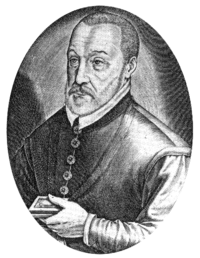Blaise de Vigenère
| Blaise de Vigenère | |
|---|---|
 |
|
| Born |
5 April 1523 Saint-Pourçain-sur-Sioule |
| Died | 19 February 1596 (aged 72) Paris |
| Nationality | French |
| Occupation | diplomat, cryptographer, alchemist |
Blaise de Vigenère (5 April 1523 – 19 February 1596) (French pronunciation: [viʒnɛːʁ]) was a French diplomat, cryptographer, translator and alchemist.
Vigenère was born into a noble family in the village of Saint-Pourçain. His father, Jean, arranged for him to have a classical education in Paris. Blaise de Vigenère studied Greek and Hebrew under Adrianus Turnebus and Jean Dorat.
At age 17 he entered the diplomatic service and remained there for 30 years, retiring in 1570. Five years into his career he accompanied the French envoy Louis Adhémar de Grignan to the Diet of Worms as a junior secretary. At age 24, he entered the service of the Duke of Nevers as his secretary, a position he held until the deaths of the Duke and his son in 1562. He also served as a secretary to Henry III.
In 1549 he visited Rome on a two-year diplomatic mission, and again in 1566. On both trips, he read books about cryptography and came in contact with cryptologists. When Vigenère retired aged 47, he donated his 1,000 livres a year income to the poor in Paris. He married a Marie Varé. He died of throat cancer in 1596 and is buried in the Saint-Étienne-du-Mont church.
The method of encryption known as the "Vigenère cipher" was misattributed to Blaise de Vigenère in the 19th century and was in fact first described by Giovan Battista Bellaso in his 1553 book La cifra del. Sig. Giovan Battista Bellaso.(published in 1553 Vigenère created a different, stronger autokey cipher in (1586). It differs from Bellasco's in several ways:
...
Wikipedia
